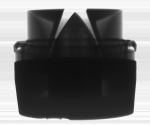Hi Rob,
Here attached is far more insightful and relevant information from the Project Array Designer himself.
See the attached documentation
https://support.jbl.com/on/demandwar...20Brochure.pdf
Being fully adjustable was a primary requirement for the Cogent main arrays.
Early on Rich and I worked on locating the balance points of each horn/driver assembly and mounting those assemblies around their balance points while having the drivers physically aligned became the basic layout for the racks.
Zero position was suspending the mid horn and driver at it's balance point with a pivot and struts that allowed a good +/- range on the vertical axis. The midbass assembly is able to move forward or backward to maintain physical alignment with the mid while moving up or down as needed to focus with the mid and the desired distance.
Finally the tweeter needed to be able to move in yet another axis to align with both of the other drivers. Sourcing all of the various hardware took a while, and once we had it Rich's machining know how was needed to adapt everything.
And then other features just help to make a cohesive system. One side of the racks distributed the signal wiring and the other side fed the field supplies. Crossover network mounted in the base of the rack.
I made a variation on these racks for my system here. I needed something shorter
eso






 Reply With Quote
Reply With Quote






